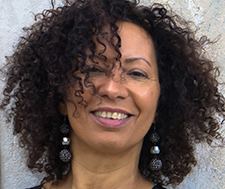The dancer….
“…Poppy, turn up the lights and let’s rock, and the waiter went off and pulled out the plug and had to pull it out again and then a third time, but as the music stopped every time he switched off the jukebox, the dancer remained in the air and made a couple of long delicate steps, her whole body trembling, and she stretched out a leg sepia one moment, then earthbrown, then chocolate, tobacco, sugar-colored, black, cinnamon now, now coffee, now white coffee, now honey, glittering with sweat, slick and taut through dancing, now in that moment letting her skirt ride up over her  round polished sepia cinnamon tobacco coffee and honey-colored knee, over her long, broad, full, elastic, perfect thighs, and she tossed her head backward, forward, to one side, to the other, left and right, back again, always back, back till it struck her nape, her low-cut, gleaming Havana-colored shoulders, the skin on them incredibly erotic, incredibly sensual, always incredible, moving them around over her bosom, leaning forward, over her full hard breasts, obviously unstrapped and obviously erect, the nipples, obviously nutritious, her tits; the rumba dancer with absolutely nothing on underneath, Olivia, she was called, still is called in Brazil, unrivaled, with no strings attached, loose, free now, with the face of a terribly perverted little girl, yet innocent, inventing for the first time the movement, the dance, the Rumba…”
round polished sepia cinnamon tobacco coffee and honey-colored knee, over her long, broad, full, elastic, perfect thighs, and she tossed her head backward, forward, to one side, to the other, left and right, back again, always back, back till it struck her nape, her low-cut, gleaming Havana-colored shoulders, the skin on them incredibly erotic, incredibly sensual, always incredible, moving them around over her bosom, leaning forward, over her full hard breasts, obviously unstrapped and obviously erect, the nipples, obviously nutritious, her tits; the rumba dancer with absolutely nothing on underneath, Olivia, she was called, still is called in Brazil, unrivaled, with no strings attached, loose, free now, with the face of a terribly perverted little girl, yet innocent, inventing for the first time the movement, the dance, the Rumba…”
“Three Trapped Tigers”
G. Cabrera Infante
Personal thanks to Patrick Mombrun who so generously shares his eclectic literary tastes with me — Michele Voltaire Marcelin.
Guillermo Gabrera Infante
Rumba Dancers in Cuba
An erotic and sensual Latin dance characterized by a slow rhythm, complex footwork and a pronounced movement of the hips. The “Rumba influence” came in the 16th century with the black slaves imported from Africa. The native Rumba folk dance is essentially a sex pantomime danced extremely fast with exaggerated hip movements and with a sensually aggressive attitude on the part of the man and a defensive attitude on the part of the woman. The music is played with a staccato beat in keeping with the vigorous expressive movements of the dancers. Accompanying instruments include the maracas, the claves, the marimbola, and the drums. Rumba’s development in Cuba dates back to the middle of the 19th century, during the Spanish colonial period. The original meaning of “rumba” refers to a community party, usually outdoors. Neighbors would gather to dance at such parties. In this sense, many claim that “rumba” refers as much to a festive atmosphere as it does to a specific dance music genre. In its present form many of the basic figures of the dance retain the age-old story of woman’s attempt to dominate man by the use of her feminine charm. In a well choreographed dance there will always be an element of “tease and run”; the man being lured and then rejected.




 Michèle Voltaire Marcelin is a poet/writer, performer and painter who was born and raised in Haiti, sojourned in Chile, and currently lives in the United States. The publication of her first novel “La Désenchantée” (CIDIHCA, Montréal-2006) was followed by its Spanish translation “La Desencantada” and two other books of poetry and prose: “Lost and Found” and “Amours et Bagatelles” (CIDIHCA, Montréal-2009) - translated into Spanish by Editorial ALBA as "Amores y cosas sin importancia" - all of which garnered rave reviews. Her writings are also featured in 3 anthologies published in France: "Cahier Haiti" (published by RAL'M-2009), "Terre de Femmes" (Editions Bruno Doucey-2011) "Revue Intranqu'îllités" (2012). She speaks and writes fluently French, English, Spanish and Haitian Creole. She has a BFA from the Leonard Davis Center for the Performing Arts at CUNY and a Masters from The New School for Social Research.
Michèle Voltaire Marcelin is a poet/writer, performer and painter who was born and raised in Haiti, sojourned in Chile, and currently lives in the United States. The publication of her first novel “La Désenchantée” (CIDIHCA, Montréal-2006) was followed by its Spanish translation “La Desencantada” and two other books of poetry and prose: “Lost and Found” and “Amours et Bagatelles” (CIDIHCA, Montréal-2009) - translated into Spanish by Editorial ALBA as "Amores y cosas sin importancia" - all of which garnered rave reviews. Her writings are also featured in 3 anthologies published in France: "Cahier Haiti" (published by RAL'M-2009), "Terre de Femmes" (Editions Bruno Doucey-2011) "Revue Intranqu'îllités" (2012). She speaks and writes fluently French, English, Spanish and Haitian Creole. She has a BFA from the Leonard Davis Center for the Performing Arts at CUNY and a Masters from The New School for Social Research.
Leave a Comment